演算法工程師修仙之路:吳恩達機器學習作業(一)
吳恩達機器學習筆記及作業程式碼實現中文版
第一個程式設計作業:單變數線性迴歸(python程式碼實現)
一元線性迴歸
-
問題描述
- 在本練習的這一部分中,您將使用只有單變數的線性迴歸方法預測餐車的利潤。
- 假設你是一家連鎖餐廳的執行長,正在考慮在不同的城市開設一家新店。
- 這家連鎖公司已經在不同的城市擁有餐車,你也有這些城市的利潤和人口資料。
- 您希望使用這些資料來幫助您選擇要擴充套件到下一個城市。
- 檔案ex1data1.txt包含線性迴歸問題的資料集。
- 第一列是一個城市的人口,第二列是該城市一輛餐車的利潤。
- 利潤的負值表示虧損。
-
繪製資料
-
在開始任何任務之前,通過視覺化來理解資料通常是有用的。
-
對於這個資料集,您可以使用散點圖來視覺化資料,因為它只有兩個屬性需要繪製(利潤和總體)。
-
你在現實生活中遇到的許多其他問題是多維的,不能在二維圖上畫出來。
-
首先,我們匯入三個python庫:numpy,pandas,matplotlib:
import numpy as np import pandas as pd import matplotlib.pyplot as plt -
然後我們使用pandas的read_csv函式讀入檔案ex1data1.txt,並打印出結果:
path = 'ex1data1.txt' data = pd.read_csv(path, header = None, names = ['Population', 'Profit']) data.head() print(data) -
結果如下表所示,僅展示前五行內容:
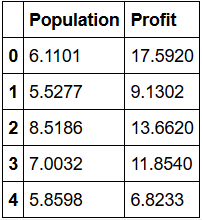
-
接著我們給上表增加描述,得到一張新的表,表的內容已全部展示:
data1 = data.describe() print(data1)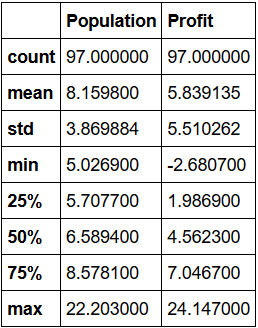
-
最後用plot方法得到訓練資料散點圖:
data.plot(kind = 'scatter', x = 'Population', y = 'Profit', figsize = (12, 8)) plt.show()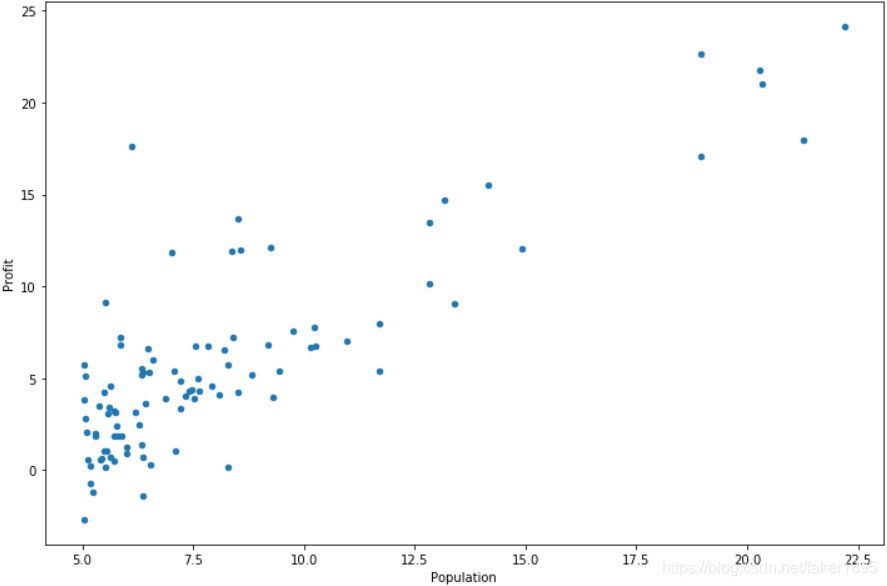
-
-
梯度下降法
-
現在讓我們使用梯度下降來實現線性迴歸,以最小化成本函式。
-
首先,我們將建立一個以引數θ為特徵函式的代價函式:
- 。
- 其中:
。
def computeCost(X, y, theta): inner = np.power(((X * theta.T)) - y, 2) return np.sum(inner) / (2 * len(X))
-
讓我們在訓練集中新增一列,以便我們可以使用向量化的解決方案來計算代價和梯度。
data.insert(0, 'ones', 1) -
現在我們來做一些變數初始化。
cols = data.shape[1] X = data.iloc[:, 0:cols-1] y = data.iloc[:, cols-1:cols] -
觀察下 X (訓練集) and y (目標變數)是否正確。
print(X.head()) print(y.head())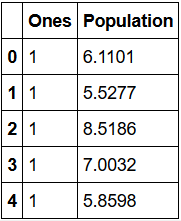
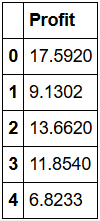
-
代價函式應該是numpy矩陣,所以我們需要轉換X和Y,然後才能使用它們,所以我們還需要初始化theta。
X = np.matrix(X.values) y = np.matrix(y.values) theta = np.matrix(np.array([0, 0])) print(theta) -
此時theta已經是一個(1,2)矩陣[[0, 0]],看下維度:
print(X.shape, theta.shape, y.shape) -
得到三個矩陣維度分別為:((97, 2), (1, 2), (97, 1))。
-
計算代價函式 (theta初始值為0):
result = computeCost(X, y, theta) print(result) -
得到結果為:32.0727338775。
-
-
批量梯度下降
-
確認梯度下降的一個好方法是觀察J(θ),然後檢查其值是否隨每一步計算而減少。假設您已經實現梯度下降法和computeCost正確,你的J(θ)不應該增加,而是應該收斂於一個穩定值的演算法。
-
先給出公式: 。
def gradientDescent(X, y, theta, alpha, iters): temp = np.matrix(np.zeros(theta.shape)) parameters = int(theta.ravel().shape[1]) cost = np.zeros(iters) for i in range(iters): error = (X * theta.T) - y for j in range(parameters): term = np.multiply(error, X[:, j]) temp[0, j] = theta[0, j] - ((alpha / len(X)) * np.sum(term)) theta = temp cost[i] = computeCost(X, y, theta) return theta, cost -
初始化一些附加變數:學習速率α和要執行的迭代次數。
alpha = 0.01 iters = 1000 -
現在讓我們執行梯度下降演算法來將我們的引數θ適合於訓練集。
g, cost = gradientDescent(X, y, theta, alpha, iters) print(g) -
得到了一個g的矩陣:[[-3.24140214 1.1272942 ]]。
-
最後,我們可以使用我們擬合的引數計算訓練模型的代價函式(誤差)。
result1 = computeCost(X, y, g) print(result1) -
得到最後的代價值為:4.51595550308。
-
現在我們來繪製線性模型以及資料,直觀地看出它的擬合。
x = np.linspace(data.Population.min(), data.Population.max(), 100) f = g[0, 0] + (g[0, 1] * x) fig, ax = plt.subplots(figsize = (12, 8)) ax.plot(x, f, 'r', label = 'Prediction') ax.scatter(data.Population, data.Profit, label = 'Traning Data') ax.legend(loc = 2) ax.set_xlabel('Population') ax.set_ylabel('Profit') ax.set_title('Predicted Profit vs. Population Size') plt.show() -
結果如下圖所示:

-
由於梯度方程式函式也在每個訓練迭代中輸出一個代價的向量,所以我們也可以繪製。請注意,代價總是降低說明這是凸優化問題的一個例子。
fig, ax = plt.subplots(figsize = (12,8)) ax.plot(np.arange(iters), cost, 'r') ax.set_xlabel('Iterations') ax.set_ylabel('Cost') ax.set_title('Error vs. Training Epoch') plt.show()
-
